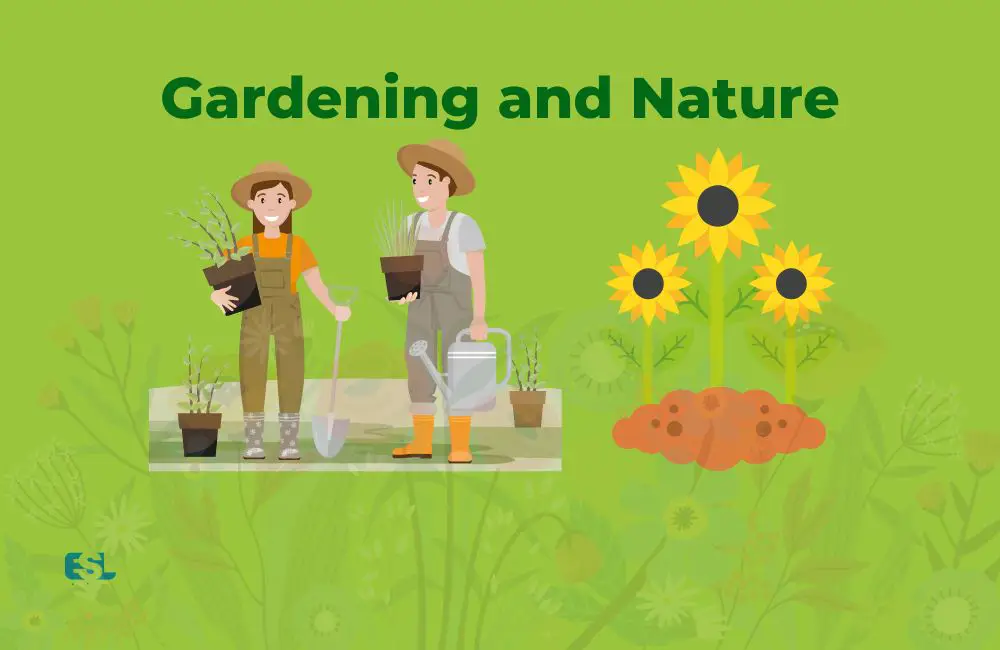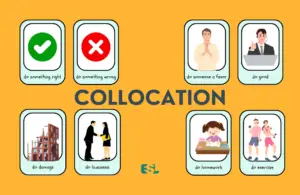Gardening is more than just a hobby; it’s a way of life for many people. From cultivating delicate flowers to nurturing hardy vegetables, this earthy activity combines science, nature, and creativity. To fully engage in the gardening world, one needs to familiarize themselves with the associated vocabulary.
This article is designed to guide you through the rich language of gardening and nature, providing an array of terms, meanings, and usage in sentences. Whether you’re an experienced horticulturist, a novice gardener, or simply someone who appreciates the natural world, this glossary will enhance your understanding and appreciation of gardening and nature.
Table of Contents
- 1. Basic Gardening Terms
- 2. Types of Gardens
- 3. Plant Structures
- 4. Soil and Fertilizer Terms
- 5. Plant Diseases and Pests
- 6. Flower Arrangement and Design
- 7. Botanical and Horticultural Terms
- Sample Conversation: Using Vocabulary Related to Gardening and Nature
- Conclusion
- FAQ: Vocabulary Related to Gardening and Nature
1. Basic Gardening Terms
The first step to understanding the gardening world is familiarizing oneself with basic terms that are commonly used in gardening practices and literature.
| Word/Phrase | Meaning/Usage | Example Sentences |
|---|---|---|
| Perennial | Plants that live for more than two years | “The lavender plant is a perennial that blooms year after year.” |
| Annual | Plants that complete their lifecycle within one year | “Marigolds are annuals; they bloom and die within a single growing season.” |
| Biennial | Plants that take two years to grow from seed to fruition and die | “Parsley is a biennial plant; it produces leaves in the first year and flowers in the second.” |
| Compost | Organic matter that has been decomposed and recycled as a fertilizer and soil amendment | “Adding compost to the soil enriches it and promotes plant growth.” |
| Pruning | Cutting back plants to remove dead or overgrown branches or stems | “Pruning the rose bush will help it to grow more vigorously.” |
| Mulch | A layer of material applied to the surface of the soil to conserve moisture, improve fertility, and reduce weed growth | “I applied mulch around the plants to retain moisture and suppress weeds.” |
| Heirloom | A plant variety that has a history of being passed down within a family or community | “Heirloom tomatoes have a richer flavor compared to modern commercial varieties.” |
| Hardiness | The ability of plants to survive adverse growing conditions | “The hardiness of the cactus allows it to thrive in the harsh desert environment.” |
| Germinate | The process by which a plant grows from a seed | “The seeds will germinate in one to two weeks with proper watering.” |
| Transplant | To move a plant from one place and replant it in another | “I had to transplant the young saplings to a sunnier location in the garden.” |
To elevate your vocabulary in just 30 days, I recommend to my students an informative, fun, and accessible guide to utilizing powerful language. Millions of individuals have enhanced their academics, job skills, and confidence by dedicating just fifteen minutes daily to the exercises and tests of 30 Days to a More Powerful Vocabulary (Amazon Link), a top-selling. It offers step-by-step methods to bolster language prowess, discover compelling words, and daily vocabulary enhancement with pronunciation guidance.
2. Types of Gardens
There are many different types of gardens, each with its unique characteristics and requirements. Here are some of the most common types.
| Word/Phrase | Meaning/Usage | Example Sentences |
|---|---|---|
| Vegetable Garden | A garden where vegetables are grown for consumption | “I planted tomatoes, cucumbers, and lettuce in my vegetable garden.” |
| Flower Garden | A garden dedicated to growing flowering plants | “My flower garden is full of roses, daisies, and sunflowers.” |
| Herb Garden | A garden where herbs are cultivated for culinary and medicinal use | “I have a small herb garden with basil, mint, and rosemary.” |
| Rock Garden | A garden style that emphasizes rocks and rugged alpine plants | “The rock garden has a natural, rustic appeal.” |
| Water Garden | A garden that features water elements and plants that thrive in wet conditions | “The water garden, with its lily pads and koi fish, offers a serene environment.” |
| Container Garden | A garden where plants are grown in containers instead of the ground, suitable for limited spaces | “My balcony container garden has tomatoes, peppers, and a variety of herbs.” |
| Butterfly Garden | A garden planted primarily with flowers that are attractive to butterflies | “Monarchs and swallowtails are frequent visitors to my butterfly garden.” |
| Zen Garden | A traditional Japanese garden designed for meditation and reflection | “The Zen garden, with its carefully raked sand and minimal plantings, provides a sense of calm.” |
| Edible Landscaping | A method of incorporating edible plants into ornamental or decorative gardens | “My edible landscaping includes berry shrubs, kale, and chard among the flowering plants.” |
| Xeriscape | A garden style designed to require minimal irrigation, often using drought-tolerant plants | “In the arid climate, a xeriscape garden is an environmentally friendly choice.” |
3. Plant Structures
Understanding the different parts of a plant can help you take better care of your garden and appreciate the complexity of plant life.
| Word/Phrase | Meaning/Usage | Example Sentences |
|---|---|---|
| Root | The part of a plant that typically lies below the surface of the soil | “The root of the plant absorbs water and nutrients from the soil.” |
| Stem | The main structural part of a plant that supports leaves, flowers, and fruits and transports fluids between the roots and the aerial parts of the plant | “The stem of the plant provides support and carries water and nutrients from the roots to the leaves.” |
| Leaf | The green, typically flat part of a plant that is attached to the stem, responsible for photosynthesis | “The leaf is where the plant produces food through photosynthesis.” |
| Flower | The seed-bearing part of a plant, often colorful or uniquely structured to attract pollinators | “The flower of the plant is designed to attract bees for pollination.” |
| Fruit | The mature ovary of a flowering plant, typically containing seeds | “The fruit of the plant contains seeds for the next generation.” |
| Seed | The small, hard part of a plant from which a new plant can grow | “The seed must be planted and nurtured to grow into a new plant.” |
| Bud | A compact growth on a plant that develops into a leaf, flower, or shoot | “The bud on the branch will soon bloom into a beautiful flower.” |
| Bark | The protective outer covering of the trunk, branches, and roots of trees and woody plants | “The bark of the tree protects it from damage and disease.” |
| Pollen | Fine powdery substance produced by flowering plants for fertilization through pollination | “Bees carry pollen from one flower to another, assisting with plant reproduction.” |
| Stamen | The male fertilizing organ of a flower, typically consisting of a pollen-containing anther and a filament | “The stamen of the flower contains the pollen necessary for fertilization.” |
4. Soil and Fertilizer Terms
Good soil is the foundation of a successful garden. Understanding the composition of your soil and how to enhance it is vital for plant health.
| Word/Phrase | Meaning/Usage | Example Sentences |
|---|---|---|
| Loam | Soil composed of a balanced mixture of clay, silt, and sand | “Loam is considered the best soil for gardening due to its balanced texture and nutrient content.” |
| pH | A measure of the acidity or alkalinity of the soil | “Blueberries prefer acidic soil with a pH of 4.5 to 5.5.” |
| Organic Matter | Material derived from the decay of plants and animals | “Organic matter enriches the soil and improves its ability to hold water.” |
| Topsoil | The uppermost layer of soil, usually richer in organic matter and nutrients | “It’s important to preserve topsoil as it’s where plants obtain most of their nutrients.” |
| Compost | Organic matter that has been decomposed in a process called composting | “Compost is often called ‘black gold’ for its valuable contribution to soil health.” |
| Fertilizer | A substance added to soil to enhance its fertility and promote plant growth | “I use an organic fertilizer to provide extra nutrients to my plants.” |
| N-P-K | Acronym for Nitrogen (N), Phosphorus (P), and Potassium (K), the three primary nutrients needed by plants | “A balanced N-P-K fertilizer supports overall plant health and growth.” |
| Manure | Animal waste used to fertilize soil | “Cow manure is a great organic fertilizer for vegetable gardens.” |
| Peat Moss | Partially decomposed plant material, used to lighten soil and retain moisture | “Peat moss is often added to potting mixes for its excellent moisture retention properties.” |
| Vermiculite | A mineral used in soil mixes to increase water retention | “Vermiculite helps keep soil moist, making it beneficial for seed starting mixes.” |
5. Plant Diseases and Pests
Part of being a gardener is dealing with plant diseases and pests. Understanding these terms will help you diagnose and treat common garden problems.
| Word/Phrase | Meaning/Usage | Example Sentences |
|---|---|---|
| Blight | A plant disease, typically one caused by fungi | “Late blight, which causes black spots on leaves and fruit, can devastate tomato plants.” |
| Rust | A fungal disease causing reddish-brown spots on plant leaves | “My beans got rust after an unusually wet summer.” |
| Mildew | A type of fungus that appears as a thin, powdery, usually white layer on the surface of plants | “Powdery mildew often affects roses, leaving a white film on the leaves.” |
| Aphid | Small sap-sucking insects that are common garden pests | “Aphids are infesting my rose bushes and sucking the life out of them.” |
| Slug | A small soft-bodied invertebrate that can damage plant foliage | “Slugs chewed holes in my lettuce leaves last night.” |
| Caterpillar | The larval stage of butterflies and moths, often damaging to plants due to their voracious eating habits | “Caterpillars are eating my cabbage plants; I need to apply a natural deterrent.” |
| Scale | Small insects that attach to plants and feed on their sap, often covered by a hard shell-like coating | “Scale insects are hard to control because of their protective covering.” |
| Nematode | Tiny, thread-like worms that live in the soil and can damage plant roots | “Nematodes are causing my tomato plants to wilt and yellow.” |
| Fungicide | A chemical that destroys or inhibits the growth of fungi | “I used a fungicide to control the powdery mildew on my grapes.” |
| Insecticide | A substance used for killing insects | “I used an organic insecticide to manage the aphid problem on my roses.” |
6. Flower Arrangement and Design
Flower arranging is a delightful aspect of gardening. Knowing these terms can help you create more beautiful and balanced arrangements.
| Word/Phrase | Meaning/Usage | Example Sentences |
|---|---|---|
| Bouquet | An attractively arranged bunch of flowers, often given as a gift or used for decoration | “I made a bouquet from the roses and daisies in my garden.” |
| Centerpiece | An important and often central item of a display or activity | “I created a vibrant floral centerpiece for the dining table.” |
| Focal Point | The center of interest or activity | “The large sunflowers provide a striking focal point in the arrangement.” |
| Balance | The concept of visual equilibrium in a floral arrangement | “The balance of colors and forms in the arrangement is pleasing to the eye.” |
| Harmony | The pleasing arrangement of parts, creating a sense of unity and balance | “There is harmony in the arrangement with all elements working together to create a cohesive look.” |
| Contrast | The arrangement of opposite elements to create visual interest | “The contrast between the bright red roses and pale green foliage is stunning.” |
| Filler Flowers | Flowers or foliage that fill the gaps in an arrangement | “Baby’s breath is often used as a filler flower in bouquets.” |
| Line Flowers | Tall flowers that establish the height, width, and shape of an arrangement | “Snapdragons, larkspur, and gladioli are examples of line flowers.” |
| Mass Flowers | Large, often rounded flowers that provide the bulk or mass of an arrangement | “Roses, lilies, and hydrangeas are examples of mass flowers.” |
| Accent Flowers | Small, eye-catching flowers that add pops of color or texture to an arrangement | “I added some accent flowers for a touch of whimsy and personality in my floral design.” |
7. Botanical and Horticultural Terms
This section explores the more technical side of plant and gardening vocabulary, offering insight into botanical and horticultural terms that are commonly used by professionals in the field.
| Word/Phrase | Meaning/Usage | Example Sentences |
|---|---|---|
| Botany | The scientific study of plants | “Studying botany has deepened my understanding of plants and their needs.” |
| Horticulture | The art, science, technology, and business involved in plant cultivation | “Horticulture involves more than just gardening; it’s a multifaceted field that combines science, art, and business.” |
| Photosynthesis | The process by which green plants use sunlight to synthesize foods with carbon dioxide and water | “Photosynthesis is how plants produce their food using sunlight, carbon dioxide, and water.” |
| Chlorophyll | A green pigment, present in all green plants, responsible for the absorption of light to provide energy for photosynthesis | “Chlorophyll gives leaves their green color and plays a vital role in photosynthesis.” |
| Xylem | The vascular tissue in plants that conducts water and dissolved nutrients upward from the root | “The xylem acts like a straw, drawing water and nutrients up from the roots to the rest of the plant.” |
| Phloem | The vascular tissue in plants that conducts sugars and other metabolic products downward from the leaves | “Phloem transports the sugars produced during photosynthesis from the leaves to the rest of the plant.” |
| Propagation | The process of growing new plants from a variety of sources: seeds, cuttings, bulbs, etc. | “Propagation is a cost-effective way to increase the number of plants in your garden.” |
| Pollination | The transfer of pollen from a male part of a plant to a female part of a plant, enabling fertilization and the production of seeds | “Bees and butterflies are important pollinators in my garden.” |
| Hybrid | A plant that is the result of crossbreeding two different plant varieties | “The hybrid tomato has the best traits of its two parent plants.” |
| Cultivar | A plant variety that has been produced in cultivation by selective breeding | “The ‘Honeycrisp’ apple is a popular cultivar known for its sweet taste and crunchy texture.” |
If you are searching for an effective English language vocabulary builder, try Word Power Made Easy: The Complete Handbook for Building a Superior Vocabulary (Amazon Link). This time-tested classic has helped millions achieve mastery of English and improve their communication skills in business, the classroom, and in life.
Sample Conversation: Using Vocabulary Related to Gardening and Nature
Situation: At a local community garden, Amy, an experienced gardener, shares some tips with Jake, a newbie eager to develop his green thumb.
Amy: Jake, I see you’ve chosen a sunny spot for your flowerbed. That’s great for plants that thrive in full sun.
Jake: Thanks, Amy. I’ve always been fascinated by perennials. Do you think they’d do well here?
Amy: Absolutely. Perennials are a good choice because they come back year after year. Just make sure to enrich the soil with good compost before planting.
Jake: I’ve heard about mulching. Should I consider it for retaining moisture?
Amy: Definitely! Mulch helps retain soil moisture, suppresses weeds, and improves soil quality. It’s a gardener’s best friend, especially for flowerbeds.
Jake: I’m also interested in herb gardening. Any advice on that?
Amy: Herbs love well-drained soil. Consider growing them in raised beds or containers. And remember, some herbs, like mint, can be invasive, so it’s better to give them their own space.
Conclusion
Understanding the language of gardening and nature can transform your interaction with the plant world. These terms provide a foundation for more effective gardening practices and a deeper appreciation for the complexities of plant life.
The vocabulary of gardening is vast and diverse, reflecting the richness and diversity of the plant kingdom. As you delve deeper into the world of gardening, you will undoubtedly encounter many more terms. Let this glossary be your starting point, a roadmap to guide your exploration and inspire your love of plants and gardening.
FAQ: Vocabulary Related to Gardening and Nature
1. What are perennials?
Perennials are plants that live for more than two years. They typically flower over and over again throughout their life span.
2. How is compost beneficial for gardening?
Compost is decomposed organic matter that enriches the soil, providing plants with essential nutrients. It also helps improve soil structure, promoting better root growth.
3. Why is mulching essential for gardens?
Mulching covers the soil surface, helping to retain moisture, suppress weeds, and regulate soil temperature. It also prevents soil erosion and can add organic matter back into the ground as it decomposes.
4. What’s the difference between annuals and perennials?
Annuals are plants that complete their life cycle in one growing season, whereas perennials return year after year.
5. Why are raised beds used in gardening?
Raised beds elevate the soil above the ground level, ensuring better drainage and reducing soil compaction. They can also make gardening more accessible by reducing the need to bend or kneel.
6. How can you prevent garden pests naturally?
Natural predators like ladybugs and praying mantises can help. Additionally, companion planting, where certain plants are grown together for mutual benefit, can deter pests.
7. What are the benefits of herb gardening?
Herb gardening allows you to grow fresh, aromatic plants that can be used for cooking, medicinal purposes, or simply for their delightful scent.
8. How do you ensure soil pH is appropriate for plants?
You can test the soil pH using a soil test kit. Depending on the result, you can then adjust the pH by adding lime (to raise it) or sulfur (to lower it).
9. What is pruning, and why is it important?
Pruning involves trimming plants by removing dead or overgrown branches or stems. It encourages healthy growth, better fruiting or flowering, and can prevent disease.
10. Why is it essential to understand a plant’s hardiness zone?
A plant’s hardiness zone indicates the range of temperatures it can withstand. Knowing your local zone helps ensure you plant species that can survive and thrive in your specific climate.






